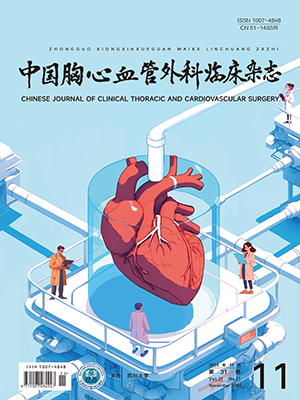Objective To examine the regression, residue, or progression of tricuspid regurgitation (TR) after mitral valve replacement so as to improve the clinical evaluation and management of TR. Methods From January 1998 to December 2003, a total of 287 consecutive patients of mitral valve replacement were followed and reviewed for this study. There were 86 male patients and 201 female patients whose ages ranged from 15 to 66 years (41.0±11.0 years). The predominant mitral vane lesion was stenosis in 199 patients (69%), regurgitation in 66 patients (23%) and mixed in 22 patients (8%). A total of 201 patients (70%) had atrial fibrillation and 86 patients (30%) were in sinus rhythm. According to ratio of maximal regurgitation area to right atrial area TR was graded as mild (+), mild-moderate (+/++) moderate (++) moderate-severe (++/+++) and severe (+++). There were 101 mild TR (36.7%), 5 mild-moderate(1.8%), 27 moderate (9.8%), 2 moderate-severe (0.7%) and 21 severe (7.6%). Depending on the surgical findings tricuspid annuloplasty was performed. The patients were followed in outpatient clinical and had echocardiography evaluation regularly. Results The follow-up ranged from 2 to 7 years (4.0±1.6 years). Twelve patients were lost during the follow-up periods. Compared with preoperation, clinical condition of the majority of patients was improved after surgery. The diameter of left atrium, right atrium, left ventricle and right ventricle decreased significantly after operation (P〈0.01). The ejection fraction and fraction of shorting increased significantly after surgery (P〈0.05). However there were no significantly changes between pre- TR and post- TR in these patients (P〉0.05). Tricuspid annuloplasty was not performed for 129 patients who had TR because TR was judged intraoperatively not to be severe. Of those patients, TR regressed in 54 patients, improved in 12 patients, did not change in 46 patients and progressed in 17 patients respectively after surgery. There were 27 patients who received De Vega tricuspid annuloplasty. Among them, TR regressed in 10 patients, improved in 12 patients and did not change in 5 patients respectively after surgery. Conclusion It is not adequate to evaluate the degree of TR in mitral valve diseases with rate of maximal regurgitation area to right atrial area. It should be improved to adopt intraoperative findings for tricuspid annuloplasty. TR may occur in patients who do not have TR before operation.
Citation: XIAO Xijun,YUAN Hongsheng,TANG Hong,HUANG Yun,ZHANG Ran,WANG Yan. The Regression, Residue or Progression of Tricuspid Regurgitation after Mitral Valve Replacement. Chinese Journal of Clinical Thoracic and Cardiovascular Surgery, 2006, 13(5): 307-310. doi: Copy




